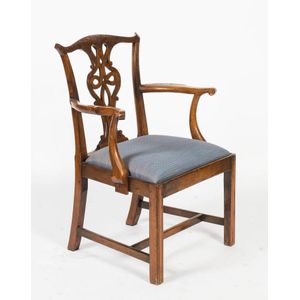Regency Mahogany Dining Chairs with Japanese Silk Upholstery
Set of six Regency mahogany dining chairs, c. 1820, comprising five dining chairs and one carver, each with carved back rail, seat covered in early Japanese silk obi fabric, together with a matching carver with pink upholstered seat, back rail (A/F) (7), height 85 cm. provenance: The Collection of Lady Sybil Joel, Sydney
You must be a subscriber, and be logged in to view price and dealer details.
Subscribe Now to view actual auction price for this item
When you subscribe, you have the option of setting the currency in which to display prices to $Au, $US, $NZ or Stg.
This item has been sold, and the description, image and price are for reference purposes only.
- Regency Period - The Regency period in English furniture design refers to the period when King George III, was declared unfit to rule in 1811, and his son ruled as proxy as Prince Regent, until 1820, and then, after the death of his father as George IV until his death in 1830. The Regency period was preceded by the Georgian period (George I, George II, and George III: 1714 - 1811), and was followed by the William IV period, which only lasted until 1837 when William IV died as was succeeded by Queen Victoria.
- A/f, as Inspected - The letters "A/F" or "as inspected" as part of a description is the cataloguer's shorthand for "all faults" or "as found", meaning the item has some type of damage or deficiency, it is of uncertain date or provenance, and/or that the seller takes no responsibility for the completeness of the item or the accuracy of the description.
- Rail - A term used by cabinet makers for the horizontal sections of the frame of an item such as a chair or settee which have a front rail, a back rail and two side rails, and also on a door or carcase, where the rails are joined to the vertical framings.
- Provenance - A term used to describe the provable history of an antique or work of art, and thus an additional aid to verifying its authenticity. Provenance can have an inflating effect on the price of an item, particularly if the provenance relates to the early settlement of Australia, a famous person, or royalty. Less significant are previous sales of the item through an auction house or dealer.
- Mahogany - Mahogany is a dense, close grained red-coloured timber from the West Indies and Central America. It was first imported into Europe in the the early 18th century and its use continued through the 19th century. It was popular for furniture making because of its strength, the wide boards available, the distinctive grain on some boards, termed flame mahogany and the rich warm colour of the timber when it was polished.. The "flame" was produced where a limb grew out from the trunk of the tree, and this timber was usually sliced into veneers for feature panels on doors, backs and cornices.
Some terms used to describe mahogany relate to the country from which it originally came, such as "Cuban" mahogany, "Honduras" mahogany etc. However unless the wood has been tested the names assigned are more a selling feature, rather than a true indication of the timber's origin.
This item has been included into following indexes:
- chairs, sets of 4, style or period - all styles 511
- chairs, sets of 6, style or period
-
chairs, sets of 6, timber
- all styles and timbers 749
- mahogany 175
Visually similar items

William IV mahogany sabre leg elbow chair with brown velvet seat, circa 1835
Sold by
in
for
You can display prices in $Au, $US, $NZ or Stg.

Six Regency mahogany dining chairs, c. 1820, with carved top rails and green velvet seats (6). Height 85 cm
Sold by
in
for
You can display prices in $Au, $US, $NZ or Stg.

A George III carved mahogany elbow chair, English, circa 1780
Sold by
in
for
You can display prices in $Au, $US, $NZ or Stg.

William IV mahogany dining chair, circa 1835
Sold by
in
for
You can display prices in $Au, $US, $NZ or Stg.
